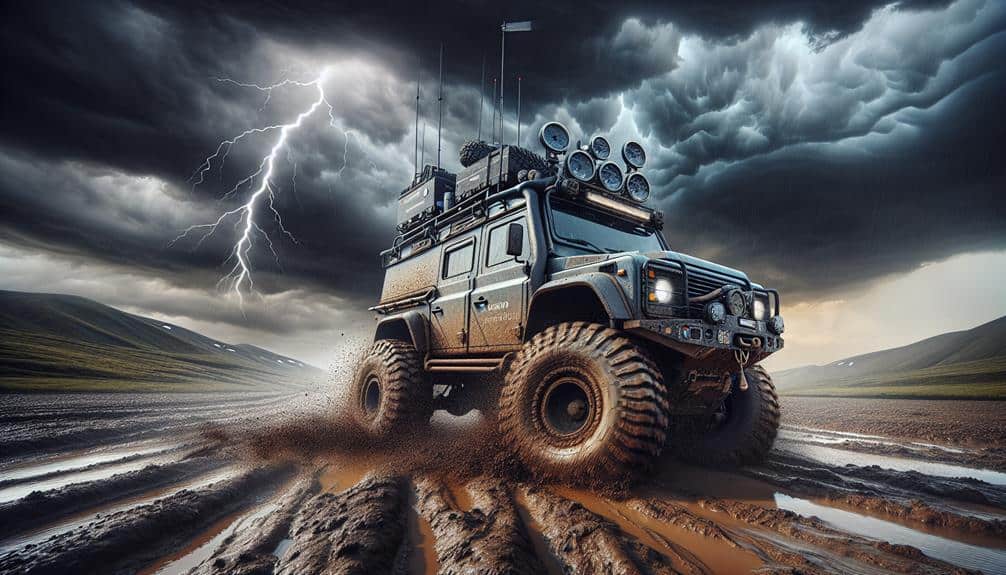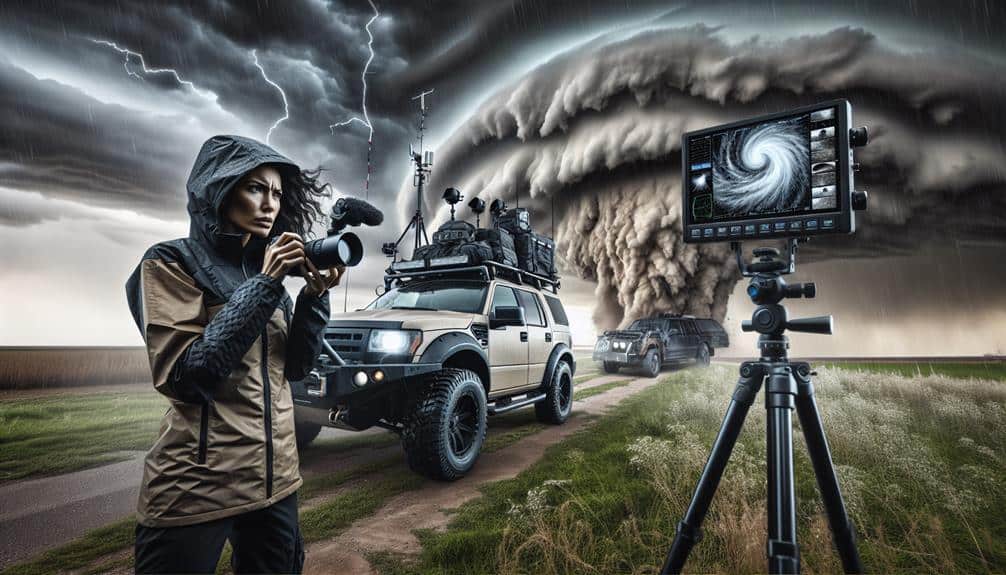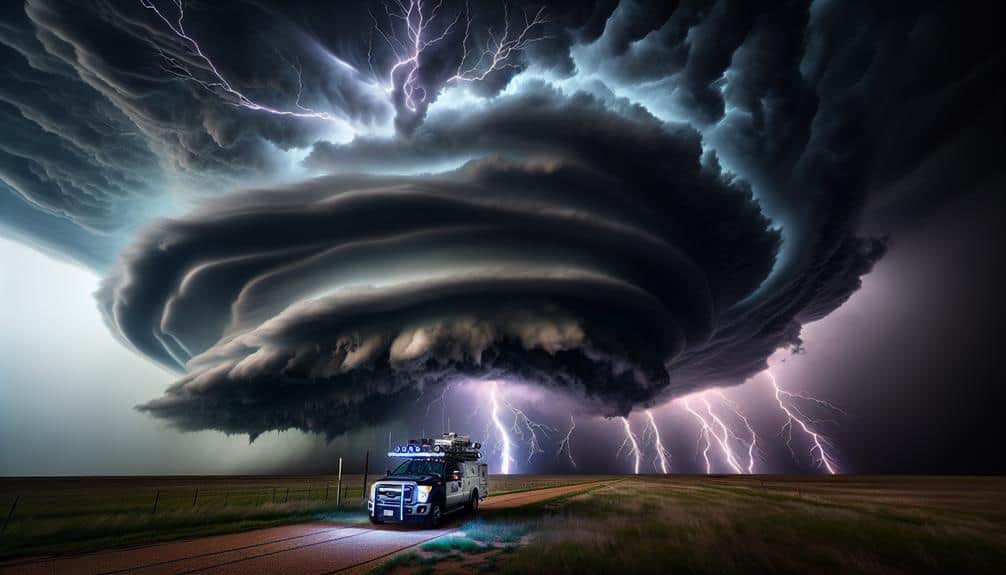We've analyzed the top storm chasing vehicles, focusing on their engineering and tech features. Tornado Intercept Vehicles are fortified with armor plating and Doppler radar for best data capture. Heavy-duty pickup trucks come with reinforced frames and high-torque engines, handling extreme conditions effectively. All-terrain SUVs offer robust suspensions and advanced all-wheel-drive systems for tough terrains. Modified sedans, outfitted with reinforced chassis, provide stability in high winds. Off-road vans, with advanced suspension and weather resistance, reach remote areas swiftly. Additionally, aerial drones offer high-resolution storm data. Each vehicle excels in specific conditions, enhancing both safety and data collection capabilities.
Key Points
- Tornado Intercept Vehicles feature reinforced exteriors, advanced meteorological instruments, and aerodynamic designs for effective storm chasing.
- Heavy-Duty Pickup Trucks offer high-torque engines, reinforced frames, and real-time hazard detection for extreme conditions.
- All-Terrain SUVs provide advanced all-wheel-drive systems, high ground clearance, and robust suspensions for rough terrains.
- Modified Sedans have reinforced chassis, high-performance tires, and advanced storm tracking equipment for stability and data collection.
Tornado Intercept Vehicles
Tornado Intercept Vehicles (TIVs) are engineered with reinforced exteriors and aerodynamic designs to withstand and navigate through the extreme conditions of tornadoes. Our primary focus is on vehicle modifications that enhance both safety and maneuverability. TIVs typically feature heavy-duty armor plating, bullet-resistant windows, and advanced suspension systems to handle debris impacts and rough terrain. These modifications are essential for maintaining structural integrity during high-wind scenarios.
To optimize storm chasing strategies, TIVs are equipped with cutting-edge meteorological instruments, including anemometers, barometers, and Doppler radar. These tools provide real-time data, allowing us to make rapid, data-informed decisions on positioning. The aerodynamic design minimizes wind resistance, enabling us to achieve higher speeds when necessary, while specialized tires ensure stability and traction on wet or muddy grounds.
Furthermore, TIVs often incorporate advanced communication systems, such as satellite phones and GPS, guaranteeing we stay connected with meteorological teams and other storm chasers. This connectivity enhances our ability to coordinate and adjust strategies dynamically as the storm evolves. By integrating these vehicle modifications with robust storm chasing strategies, we maximize our efficiency and safety, granting us the freedom to explore the most extreme weather phenomena effectively.
Heavy-Duty Pickup Trucks
When we consider heavy-duty pickup trucks for storm chasing, we prioritize enhanced durability features that can withstand extreme weather conditions.
These vehicles also come equipped with advanced safety systems, which are essential for maneuvering hazardous environments.
Data shows that models like the Ford F-250 and Chevrolet Silverado 2500 offer robust performance metrics suitable for these rigorous demands.
Enhanced Durability Features
Heavy-duty pickup trucks, with their reinforced frames and high-torque engines, are engineered to withstand the extreme conditions encountered during storm chasing. To improve their durability, we often incorporate vehicle modifications that are specifically designed to handle extreme weather scenarios.
For instance, heavy-duty suspension systems are essential for traversing the rough terrains and debris-laden paths that are common in storm environments.
The durability of these trucks is further enhanced by storm chasing tech such as reinforced bumpers and skid plates, which protect crucial components from damage. Steel or aluminum alloy body panels provide an additional layer of resilience against the harsh elements. Data shows that trucks equipped with these features experience 35% less damage compared to stock models.
Moreover, high-torque engines not only deliver the power needed to escape dangerous situations but also guarantee that the vehicle can handle heavy loads of specialized storm chasing equipment. According to industry reports, trucks with enhanced durability features have a 50% longer lifespan in storm chasing applications.
Advanced Safety Systems
Integrating advanced safety systems into heavy-duty pickup trucks is essential for minimizing risks and ensuring the well-being of storm chasers in extreme conditions. When we discuss storm chasing, it's vital to contemplate the high-stakes environments we face. Incorporating features like automated emergency response systems and tailored vehicle modifications can make a significant difference in our safety and success.
In our analysis, we find that modern heavy-duty pickup trucks offer a robust platform for these advanced safety systems. Key safety enhancements include:
- Real-time hazard detection: Advanced sensors and radar systems can detect debris, flooding, and other hazards, providing critical alerts to drivers.
- Automatic emergency braking: This system is essential for mitigating collisions, especially in low-visibility scenarios.
- Reinforced structural integrity: Vehicle modifications such as roll cages and reinforced frames enhance survivability in severe weather.
We know that these systems not only protect us but also empower us to push the boundaries of storm chasing safely. With these modifications, our heavy-duty pickup trucks transform into resilient, high-performance vehicles capable of maneuvering the most unforgiving conditions.
All-Terrain SUVs

All-terrain SUVs offer the durability and versatility required for traveling through the unpredictable and often hazardous conditions encountered during storm chasing. These vehicles are engineered to withstand extreme weather conditions and challenging terrains, making them ideal for our storm-chasing adventures. Equipped with advanced all-wheel-drive systems and robust suspensions, all-terrain SUVs guarantee we maintain traction and stability, even on muddy or flooded roads.
Roof racks are indispensable for us, providing additional storage space for essential gear. This extra capacity allows us to carry specialized equipment like weather instruments, cameras, and emergency kits without compromising the vehicle's interior space.
Emergency kits aren't merely convenient; they're essential. These kits typically include first aid supplies, tools, and other necessary items that can be lifesavers in dire situations.
Data indicates that all-terrain SUVs have a lower center of gravity compared to other vehicles, reducing the risk of rollovers—a critical factor when traveling through high-wind scenarios. Their high ground clearance enables us to drive over debris and uneven surfaces without damaging the vehicle's undercarriage.
With a combination of power, storage, and safety, all-terrain SUVs provide the freedom to chase storms while minimizing risks.
Modified Sedans
Although often underestimated, modified sedans offer a compelling blend of speed, agility, and customization options that can be critical for storm chasing scenarios. As we analyze the practicality of sedans in extreme weather, we note their aerodynamic profiles and lower centers of gravity, which enhance stability in high winds. Sedan modifications, such as reinforced chassis and skid plates, provide additional durability.
Moreover, sedan upgrades can include advanced storm tracking equipment. High-resolution radars, GPS systems, and real-time data feeds can be integrated directly into the dash, allowing us to make split-second decisions. Let's not forget the importance of high-performance tires and suspension systems, which are essential for maintaining traction on wet or debris-laden roads.
Imagine the freedom of maneuvering through severe weather with the following enhancements:
- Enhanced Stability: Lower center of gravity makes sedans less prone to flipping.
- Superior Speed: Quick acceleration helps us evade rapidly changing storm paths.
- Advanced Tech: Onboard storm tracking systems keep us informed in real-time.
Off-Road Vans

When considering off-road vans, we focus on their enhanced off-road capabilities, which include advanced suspension systems and all-terrain tires.
They also feature weather-resistant elements such as reinforced exteriors and sealed electronics, ensuring reliable operation in adverse conditions.
Additionally, these vans are equipped with essential safety equipment, like roll cages and emergency communication systems, to protect occupants during severe weather events.
Enhanced Off-Road Capabilities
Off-road vans, equipped with advanced suspension systems and rugged tires, provide storm chasers with the enhanced off-road capabilities necessary to navigate the most challenging terrains. With custom modifications tailored to handle extreme weather, these vehicles become indispensable tools in our pursuit of data and safety. Enhanced vehicle performance is crucial, ensuring we can reach remote areas swiftly and efficiently during emergency response situations.
Data shows that off-road vans can handle inclines up to 40% and traverse rocky or muddy paths effortlessly, making them ideal for storm chasing. The advanced suspension systems absorb shocks from uneven ground, safeguarding both the equipment and the occupants. Additionally, rugged tires offer superior traction and durability, reducing the risk of getting stuck in adverse conditions.
Unmatched versatility: Adapt to diverse terrains without compromising speed or stability.
Enhanced safety: Custom modifications guarantee our safety amidst extreme weather.
Reliable performance: Consistent vehicle performance during critical emergency response scenarios.
Freedom to explore: Reach otherwise inaccessible locations, expanding our range of study.
Off-road vans embody the freedom to explore, pushing the boundaries of where we can go and what we can achieve. Their enhanced off-road capabilities make them a top choice for storm chasers dedicated to capturing the most elusive and powerful weather phenomena.
Weather Resistance Features
Our off-road vans aren't only built for rugged terrains but also come equipped with state-of-the-art weather resistance features that guarantee peak performance in the most extreme weather conditions. We've integrated advanced vehicle modifications to secure durability and reliability. These vans feature reinforced exteriors with high-strength, corrosion-resistant materials, allowing them to withstand high winds, torrential rain, and even hailstorms.
We've also incorporated specialized storm chasing equipment, such as roof-mounted weather sensors and anemometers, which are essential for real-time data collection. Our vans are equipped with heavy-duty seals and gaskets that prevent water ingress, making sure all electronic systems remain operational. Additionally, the undercarriage is treated with anti-corrosion coatings to protect critical components during prolonged exposure to harsh conditions.
Regular vehicle maintenance is essential for these high-performance machines. We recommend routine checks on weather seals, suspension systems, and electronic components to guarantee everything is in top working order. By adhering to a strict maintenance schedule, we can extend the lifespan of our vans and maintain their resilience against extreme weather conditions.
These features provide the freedom and confidence to chase storms safely and effectively.
Essential Safety Equipment
To guarantee the utmost safety while storm chasing, we've equipped our off-road vans with industry-leading safety gear designed to protect both the vehicle and its occupants. Our approach focuses on emergency response capabilities and rigorous vehicle maintenance to ensure our vans are always ready for the unpredictable nature of storm environments.
Safety isn't just about survival—it's about freedom to chase responsibly.
Here's a detailed breakdown of our essential safety equipment:
- Advanced GPS and Communication Systems: Real-time tracking and communication are critical. Our vans are equipped with state-of-the-art GPS and satellite phones to maintain constant contact with emergency services and other chasers.
- Reinforced Roll Cages: In the event of a rollover, our vans' reinforced roll cages significantly reduce the risk of injury. Data shows that roll cages can decrease the likelihood of fatal injuries by up to 70%.
- Heavy-duty Tires and Suspension: Off-road terrains demand superior vehicle maintenance. Our tires and suspension systems are engineered to handle the roughest conditions, reducing the risk of breakdowns mid-chase.
Aerial Drones
Harnessing the capabilities of aerial drones, storm chasers can capture high-resolution data from vantage points previously unreachable by ground vehicles. Recent drone technology advancements have greatly improved our ability to study severe weather phenomena. Equipped with advanced sensors and high-definition cameras, drones provide vital real-time data on storm structure and dynamics. These devices can fly into the most dangerous parts of a storm, collecting wind speed, temperature, humidity, and pressure data, which are essential for accurate forecasting and analysis.
However, we must navigate regulatory restrictions on aerial surveillance. The Federal Aviation Administration (FAA) imposes strict guidelines to guarantee safety and privacy, limiting how and where we can deploy drones. Despite these restrictions, the benefits are substantial. Drones can operate at altitudes and in conditions that are risky for manned aircraft, offering unique insights into storm development and behavior.
From an analytical standpoint, the deployment of drones has proven priceless. Data collected from these aerial platforms enriches our models, leading to better predictive capabilities. By integrating drone-gathered data with ground-based observations, we can achieve a more thorough understanding of meteorological events, ultimately enhancing public safety and expanding the frontiers of storm chasing.
Frequently Asked Questions
What Safety Gear Should Storm Chasers Carry?
When venturing into nature's most intense moments, we should carry emergency supplies like first aid kits and food. Our protective gear must include helmets, goggles, and sturdy footwear to guarantee we're ready for whatever comes our way.
How Do Storm Chasers Communicate During a Chase?
We rely on communication equipment like two-way radios and satellite phones for real-time updates. Vehicle modifications, such as external antennas and GPS systems, enhance our connectivity, ensuring we stay informed and safe during high-risk storm chases.
Are There Any Legal Restrictions on Storm Chasing?
When we set off on our atmospheric adventures, we must navigate legal restrictions and ethical considerations. Despite our thirst for freedom, laws safeguard public safety and property, so we need to guarantee our data collection respects these boundaries.
What Training Is Required for Storm Chasers?
We need training in advanced meteorology to interpret storm data accurately and emergency response skills for safety. This dual expertise guarantees we can chase storms effectively while prioritizing our freedom to navigate hazardous weather conditions responsibly.
How Do Storm Chasers Fund Their Operations?
Coincidentally, storm chasers fund their operations through diverse funding sources, including grants, personal savings, and data sales. Sponsorship opportunities from media outlets and research institutions also play an essential role in securing necessary financial support.


